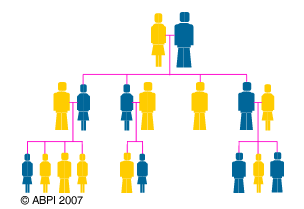This topic takes on average 55 minutes to read.
There are a number of interactive features in this resource:
 Biology
Biology
Mutations can occur randomly during DNA replication. The chance of a mutation occurring is increased by exposure to certain chemicals and radiations- these are known as mutagens. If a mutation results in cancer, the mutagens responsible are known as carcinogens.
Examples of mutations include addition, deletion and substitution of nucleotide bases. The majority of mutations are not harmful or fatal. Most mutations are neutral, a small number are harmful and a small number give a new characteristic that gives the organism a selective advantage.
If the mutation occurs in a gene, it can alter the amino acid sequence coded. Modifying the amino acid sequence of a polypeptide chain can have various consequences including modifying protein structure. Hydrogen, ionic and disulphide bonds hold the tertiary and quaternary structures of proteins together. Amino acid changes can disrupt these bonds- or even create new bonds. This can transform the structure of a protein. Structural modifications of a protein can change the shape of its active site, change its function, or stop it functioning.
If the mutation occurs within a non-coding gene promoter region, it can result in increased or decreased levels of protein expression. These mutations can influence the frequency of transcription by altering the affinity of RNA polymerase for the sequence.
Individuals can also be missing a chromosome or have an extra one. Down’s syndrome is caused in humans by the presence of an extra copy of chromosome 21.

Down syndrome human karyotype 47, XY, +21
Cystic fibrosis (CF) is a genetic disorder that affects mostly the lungs. Symptoms include difficulty breathing and mucus coughing as a consequence of lung infections. Its inheritance is recessive, which means you need the two faulty recessive alleles in order to suffer the disease.
Unlike cystic fibrosis, Huntington’s Disease is dominant. Therefore, it can be inherited even if just one parent has this faulty allele.
The diagram shows what can happen if one parent has the HD gene (and therefore has Huntington’s disease) and the other parent does not. In this diagram the presence of the disease is shown by a capital H. In Huntington’s the symptoms do not show until the sufferer is 35-40 years of age, by which time the faulty gene may have been passed on to children and even grandchildren.
Continuing genetic research has meant development of tests for some genetic diseases both in utero and after birth and treatments such as gene therapy.
A pedigree chart is a diagram that shows the appearance of a disease within a family. They can be used to understand the inheritance of a disease, recapitulate the genotypes of previous generations and even predict the change of future generations being affected by it.
